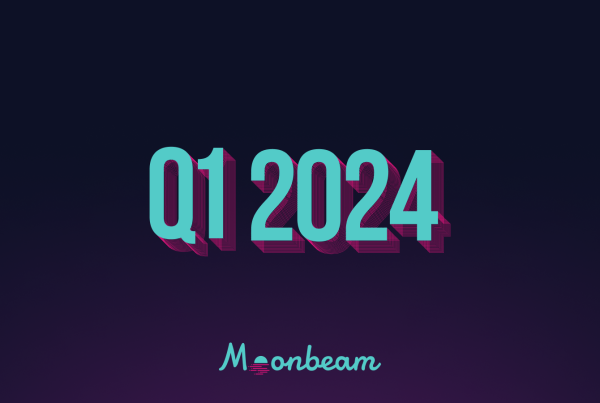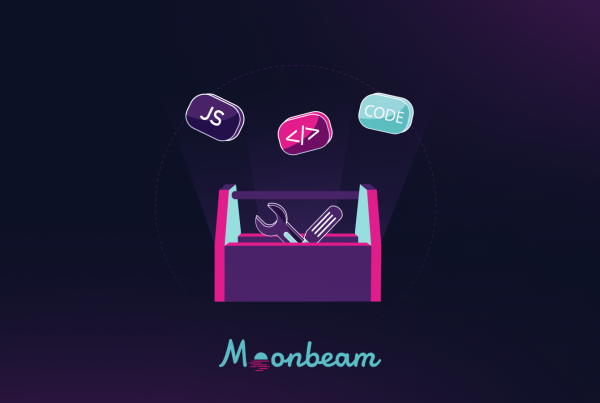Moonbeam was designed to cater to a future where multiple blockchain networks seamlessly communicate and collaborate. Embracing the concept of a multichain Web3 environment, Moonbeam is thus created with the latest advancements in cross-chain messaging systems, including the XCM (Cross-Consensus Messaging) release and the growth of GMP (General Message Passing) protocols. Read more about them in Part 1 of the “Fast Finality on Moonbeam” series…
XCM and GMP allow developers to tap into an expansive array of messaging systems, providing unparalleled flexibility and connectivity for cross-chain applications. With Moonbeam’s foundational design focused on interoperability, platforms like Prime Protocol leverage its capabilities to create innovative, efficient solutions in the ever-evolving blockchain landscape.
But in the Web3 world, what slows down finality, and in detail, how is Moonbeam a unique solution?
Finality in Layer 1 VS. Layer 2 Networks
Speed to Finality can differ significantly depending on the type of blockchain architecture. Legacy layer 1 networks like Ethereum may suffer from slow confirmation times that hinder usability, but the more you pay, the more you will be prioritized. Innovative solutions like layer 2 scaling solutions also introduce trade-offs to their scaling around transaction settlement and finality.
Finality in Layer 2 solutions, such as rollups or sidechains, is often slower compared to Layer 1 blockchains due to their dependency on the underlying mainchain for security and transaction finalization. These Layer 2 systems process transactions off the mainchain to increase throughput and reduce costs. However, they periodically need to commit their state or prove the validity of their transactions to the mainchain.
This reliance delays achieving finality because it’s contingent on the mainchain’s finality. I.e. Layer 2 Rollups finality is given by Ethereum mainnet finality. Additionally, the mechanism for securing and validating these off-chain transactions, whether through fraud proofs or zero-knowledge proofs, can introduce further latency in finality, as these processes are inherently more complex and time-consuming than direct Layer 1 transactions.
Finality Trade-offs in Layer 2 Solutions
Layer 2 solutions on Ethereum, such as Optimism and other similar frameworks, can be slower when it comes to finality due to their architectural design and underlying consensus mechanisms. These layer 2 solutions are built as an additional layer on top of the Ethereum mainnet to offload some transaction processing and computational load.
In Layer 2 solutions, transactions are initially processed quickly on the L2 (not on the base chain, like Ethereum) and later committed to the Ethereum mainnet. This approach allows for higher scalability by reducing the number of transactions directly executed on the mainnet. However, these transactions’ speed to finality depends on the security guarantees provided by the Ethereum mainnet.
Since layer 2 solutions rely on the Ethereum mainnet for finality, they need to wait for the confirmation and inclusion of their proofs in Ethereum’s blocks. This introduces an additional factor, as these transactions must follow the consensus protocol and adhere to the block confirmation times of the Ethereum mainnet. The end result is that layer 2 solutions have slightly slower finality compared to native on-chain transactions on Ethereum.
It’s important to note that different layer 2 solutions may have varying levels of finality latency depending on their specific design, consensus mechanisms, and integration with the Ethereum mainnet. However, the reliance on the mainnet for finality does introduce an inherent delay in achieving transaction confirmations, which can impact the overall speed and responsiveness of layer 2 solutions compared to other blockchain environments with faster consensus mechanisms or dedicated cross-chain interoperability solutions.
Finality in a Multi-Chain World
When it comes to cross-chain transactions, achieving finality can be a slower process compared to transactions confined within a single network that stems from the intricate nature of cross-chain interactions. From dealing with multiple blockchain confirmations to tackling interoperability challenges and security considerations, understanding what slows down finality in cross-chain transactions is vital to grasp the full scope of this intricate process.
Cross-chain transactions, which involve transferring assets or data between different blockchain networks, often take longer to be finalized compared to transactions within a single blockchain network. There are several reasons for this:
Confirmation on Multiple Blockchains
Cross-chain transactions typically require confirmation on multiple blockchains involved in the transaction. Each blockchain has its own consensus mechanism and confirmation process, which adds to the overall transaction time.
 Time Synchronization
Time Synchronization
Blockchains operate on their own independent timeframes, and achieving synchronization between different chains can be challenging. Ensuring accurate timing and sequencing of transactions across chains can introduce delays.
 Interoperability Challenges
Interoperability Challenges
Interoperability between different blockchains is a complex task. Cross-chain transactions often involve different protocols, smart contract languages, or consensus mechanisms. Implementing interoperability solutions can require additional time for development and testing.
 Bridge Operations
Bridge Operations
Cross-chain transactions often rely on bridges or relays that facilitate communication between different blockchains. These bridges introduce an extra layer of complexity, as they need to handle message passing, asset locking, and verification processes. Bridge operations can contribute to the overall transaction time.
 Security Considerations
Security Considerations
Cross-chain transactions require additional security measures to ensure their integrity and correctness across multiple chains. These security checks and verifications can extend the time required for transaction finality.
 How Moonbeam’s Finality Scales Prime Protocol
How Moonbeam’s Finality Scales Prime Protocol
Prime Protocol is at the forefront of blockchain innovation, working on the creation of the first natively cross-chain prime brokerage. They’re building a platform where users can secure stablecoin loans by using their digital assets as collateral. What’s groundbreaking about Prime Protocol is its ability to work seamlessly across different blockchains. This means you can deposit your assets on one blockchain and access loans on another. In the world of decentralized finance (DeFi), this level of interoperability is quite rare. Prime Protocol has chosen to build on Moonbeam, a blockchain that excels in cross-chain functionality, to make all of this possible.
Why Does Prime Protocol Need Fast Finality?
In the case of a cross-chain brokerage like Prime Protocol, the challenges of delays in finality become particularly pronounced. As a lending and borrowing platform, it serves as an intermediary between blockchains, enabling users to access liquidity, supply assets, and borrow assets across chains. However, the delay in finalizing transactions across multiple chains can hinder the protocol’s efficiency and responsiveness.
For instance, asset transfers, collateralization, loan origination, and repayments can be prolonged, impacting the overall user experience and posing potential market volatility, price fluctuations, and capital allocation risks.
Ensuring timely finality is crucial to maintaining the integrity of the protocol’s operations, accurate collateral accounting, effective risk management, and facilitating seamless cross-chain asset utilization for users. Therefore, overcoming the challenges of finality slowness is crucial for a project like Prime to deliver efficient and secure services in the decentralized finance (DeFi) ecosystem.
Achieving cross-chain interoperability and ensuring finality pose several other challenges. Different blockchain networks may have varying block confirmation times, meaning that the time it takes for a transaction to be considered final can differ significantly across chains. This inconsistency can complicate the management of collateral and loan repayments, as timely finality is crucial for maintaining accurate asset ownership and managing risk.
Moonbeam Vs. L2 Solutions
For Prime, Moonbeam is a solution to the challenges of finality speed in cross-chain dApps. Moonbeam is a specialized blockchain platform that provides an Ethereum-compatible environment on the Polkadot network. By leveraging Moonbeam, Prime can benefit from its speed and interoperability mechanisms.
As mentioned in “Fast Finality on Moonbeam (Part 1)” Moonbeam is built on the Polkadot network and utilizes the Relay Chain that employs a consensus mechanism called nominated proof of stake (NPoS). NPoS provides faster finality compared to many layer 2 solutions or other blockchains. This means that once a transaction is confirmed on Moonbeam, it is considered final and cannot be reversed.
Moonbeam’s consensus mechanism reduces the time required for block confirmation, enabling quicker transaction finality. As a result, cross-chain transactions that are a core part of dApps like Prime protocol can be processed more rapidly, reducing the time users have to wait for asset transfers, collateralization, borrowing, and other operations.
In addition, Moonbeam helps ensure the timely execution of transactions, reducing the risks associated with price fluctuations and market volatility. Users can experience faster confirmation times, enabling them to utilize assets and access liquidity more efficiently across blockchains. By deploying on Moonbeam as opposed to layer 2 solutions, Prime Protocol benefits from the faster finality provided by Moonbeam’s underlying Polkadot network while serving customers across networks with ease.
Conclusion
Fast finality in the blockchain realm is about ensuring that transactions are both irreversible and swift. Moonbeam, with its rapid finality mechanism on the Polkadot network, excels in this area, facilitating quick and secure cross-chain transactions and decentralized applications.
In contrast, Layer 2 solutions often rely on the mainnet for finality, introducing delays. Prime Protocol, a cross-chain prime brokerage, has chosen Moonbeam to navigate these challenges, delivering efficient, secure services to users in the decentralized finance (DeFi) ecosystem.





